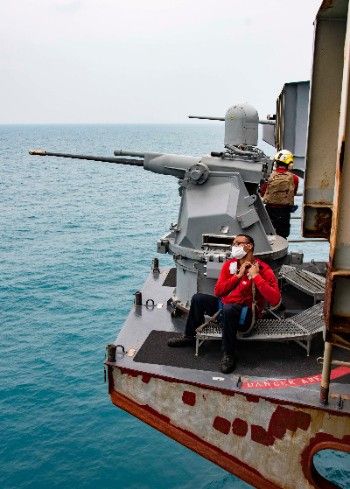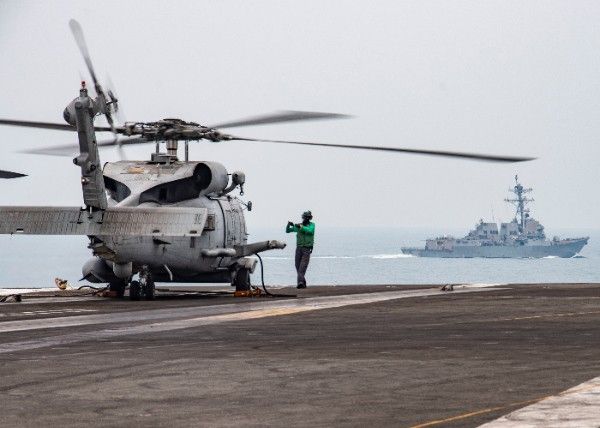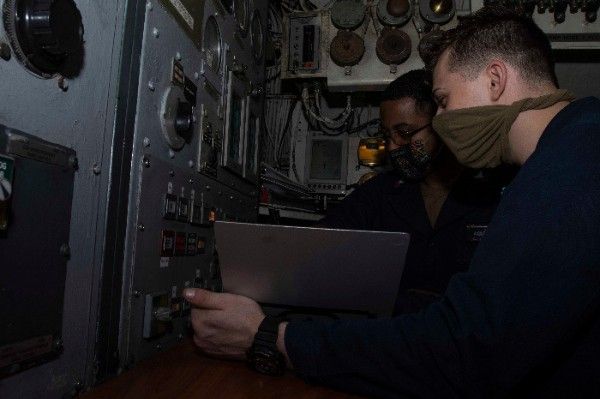Tougher US policy on South China Sea came after it deployed strike groups in the area

MANILA, Philippines — A rhetorical back-and-forth between the United States and China is unfolding following Washington's announcement of a new policy that would treat Beijing's pursuit of resources in the dispute-rife South China Sea as illegal.
The US has long rejected Beijing's sweeping claims in the South China Sea, which is both home to valuable oil and gas deposits and a vital waterway for the world's commerce.
However, a statement delivered by US Secretary of State Mike Pompeo on Monday went further by explicitly acknowledging Southeast Asian nations' claims over the waters, including the Philippines and Vietnam.
In previous years, the United States maintained that it took no position on individual territorial claims. While this is maintained in the text, it also makes clear that China has no right to bully its rival claimants.
FULL TEXT: New US policy rejects most Chinese claims in South China Sea
In response, Beijing rejected what it called the "unjustified" new policy and accused Washington of "exaggerating" the situation in the area.
Before this exchange, the United States was already touting its naval might in the contested waters in response to several moves made by China—as the world was preoccupied with the coronavirus lockdowns— to strengthen its military presence in the area.
Freedom of navigation operations
Earlier this month, the United States Navy conducted high-end integrated exercises among two of its carrier strike groups in the Philippine Sea and the South China Sea.
Sailors from the USS Nimitz and USS Ronald Reagan—which form the Nimitz Carrier Strike Force—carried out dual-carrier operations in the Philippine Sea on July 3. On July 4, the strike groups also had several tactical exercises in the disputed South China Sea.
WATCH: US flexes naval powers in Philippine seas to celebrate Independence Day
The Navy's Seventh Fleet called the move a "reinforcement of US commitment to freedom." FONOPs are understood as a way to deter adversaries and challenge maritime claims deemed excessive under international law.





Before countries across the globe were placed under coronavirus-induced lockdowns, the USS Montgomery conducted the first South China Sea FONOP of 2020 in late January which was followed by two other operations conducted by the USS Bunker Hill and the USS Barry in April.
The Diplomat logged four freedom of navigation operations conducted by the United States in 2019.
Observers noted last year that FONOPs being conducted by the United States were failing to deter China from advancing its massive maritime and territorial expansion in the region.
READ: FONOPS to counter China in WPS has failed – experts
China undeterred
In March, China seized the opportunity provided by the coronavirus-induced lockdowns in other countries to build new facilities on Philippine-claimed territories in West Philippine Sea.
Government-funded Chinese Academy of Sciences launched two research stations on Fiery Cross (Kagitingan) and Subi Reefs in Spratly Islands to “help scientists expand their research into deep-sea ecology, geology, environment, material sciences and marine energy,” state-run Xinhua reported.
READ: With world busy fighting coronavirus, China quietly builds installations on Philippine-claimed reefs
China also hinted that it would impose an air defense identification zone (ADIZ) in the South China Sea, which high ranking military officials from both the US and the Philippines tagged as illegal under international law.
Retired Senior Associate Justice Antonio Carpio, meanwhile, warned that China's intent to impose the ADIZ signalled its plans to reclaim Scarborough or Panatag Shoal.
As China's aggressions in the region mounted amid the pandemic, Filipino fishermen in June suffered yet another collision with a Chinese vessel. After three days of search and rescue operations for the 12 missing fishermen and two passengers aboard the fishing boat, the Philippine Coast Guard shifted to search and retrieval operations.
READ: Coast Guard readies charges vs Chinese vessel in Mindoro collision
The government maintains that this incident is isolated, and has nothing to do with the maritime dispute with China, even as a similar incident at Recto Bank unfolded almost exactly a year before this one. — with reports from Patricia Viray
- Latest
- Trending



































